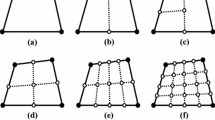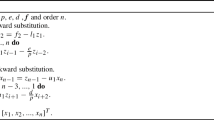Abstract
This paper presents new results of the theoretical study of factorized sparse approximate inverse (FSAI) preconditionings. In particular, the effect of the a posteriori Jacobi scaling and the possibility of constructing FSAI preconditioners iteratively are analyzed. A simple stopping criterion for the termination of local iterations in constructing approximate FSAI preconditioners using the PCG method is proposed. The results of numerical experiments with 3D finite-element problems from linear elasticity are presented. Bibliography21 titles.
Similar content being viewed by others
References
M. W. Benson and P. O. Frederickson, “Iterative solution of large sparse linear systems arising in certain multidimensional approximation problems,”Utilitas Math.,22, 127–140 (1982).
M. Benzi, C. D. Meyer, and M. Tuma, “A sparse approximate inverse preconditioner for the conjugate gradient method,”SIAM J. Sci. Comput.,17, 1135–1149 (1996).
M. Benzi and M. Tuma, “A sparse approximate inverse preconditioner for nonsymmetric linear systems,” Tech. Rep. No. 653, Oct. 1995, Inst. Computer Science, Academy of Sciences of the Czech Republic (1995).
E. Chow and Y. Saad, “Approximate inverse preconditioners for general sparse matrices,” Res. Rep. UMSI 94/101, Univ. of Minnesota, Supercomputer Inst., Minneapolis, Minnesota (1994).
E. Chow and Y. Saad, “Approximate inverse techniques for block-partitioned matrices,” Res. Rep. UMSI 95/13, Univ. of Minnesota, Supercomputer Inst., Minneapolis, Minnesota (1995).
P. Concus, G. H. Golub, and D. P. O’Leary, “A generalized conjugate gradient method for the numerical solution of elliptic partial differential equations,” in:Sparse Matrix Computations, J. R. Bunch and D. J. Rose, Academic Press, New York (1976), pp. 309–332.
P. Dewilde and E. F. Deprettere, “Approximate inversion of positive matrices with applications to modelling,” In:Modelling, Robustness, and Sensitivity Reduction in Control Systems, R. F. Curtain, ed., NATO ASI Series,F 34, 211–238 (1987).
N. I. M. Gould and J. A. Scott, “On approximate-inverse preconditioners,” Tech. Rep. RAL 95-026, Rutherford Appleton Lab., Chilton, England (1995).
M. Grote and H. Simon, “Parallel preconditioning and approximate inverses on the Connection Machine,” in:Proceedings of the Sixth SIAM Conference on Parallel Processing for Scientific Computing, R. Sincovec et al., eds., SIAM, Philadelphia (1993), pp. 519–523.
F. A. Gruzinov, L. Yu. Kolotilina, and A. Yu. Yeremin, “Block SSOR preconditionings for high order FE systems, III: Incomplete BSSOR preconditionings,”Numer. Linear Algebra Appl.,4, 393–423 (1997).
Y. P. Hong and C. T. Pan, “A lower bound for the smallest singular value,”Linear Algebra Appl.,172, 27–32 (1992).
R. Horn and C. Johnson,Topics in Matrix Analysis, Cambridge Univ. Press (1991).
T. Huckle and M. Grote, “A new approach to parallel preconditioning with sparse approximate inverses,” Manuscript SCCM 94-03, Scientific Computing and Computational Mathematics Program, Stanford Univ., Stanford, California (1994).
I. E. Kaporin, “An alternative approach to estimating the convergence rate of the CG method,” in:Numerical Methods and Soltware [in Russian], Yu. A. Kuznetsov, ed., Dept. of Numerical Mathematics, USSR Academy of Sciences, Moscow (1990), pp. 55–72.
I. E. Kaporin, “Explicitly preconditioned conjugate gradient method for the solution of unsymmetric linear systems,”Int. J. Comput. Math.,40, 169–187 (1992).
I. E. Kaporin, “New convergence results and preconditioning strategies for the conjugate gradient method,”Numer. Linear Algebra Appl.,1, 179–210 (1994).
I. E. Kaporin, “The trace/determinant condition number: several properties and application to polynomial preconditionings,”Numer. Linear Algebra Appl. (submitted).
L. Yu. Kolotilina and A. Yu. Yeremin, “On a family of two-level preconditionings of the incomplete block factorization type,”Sov. J. Numer. Math. Model.,1, 293–320 (1986).
L. Yu. Kolotilina and A. Yu. Yeremin, “Factorized sparse approximate inverse preconditionings. I: Theory,”SIAM J. Matrix Anal. Appl.,14, 45–58 (1993).
L. Yu. Kolotilina and A. Yu. Yeremin, “Factorized sparse approximate inverse preconditioning. II: Solution of 3D FE systems on massively parallel computers,”Int. J. High Speed Computing,7, 191–215 (1995).
D. P. O’Leary, “The block conjugate gradient algorithm and related methods,”Linear Algebra Appl.,29, 293–322 (1980).
Additional information
Translated fromZapiski Nauchnykh Seminarov POMI, Vol. 248, 1998, pp. 17–48.
Translated by L. Yu. Kolotilina.
Rights and permissions
About this article
Cite this article
Yeremin, A.Y., Kolotilina, L.Y. & Nikishin, A.A. Factorized sparse approximate inverse preconditionings. III. Iterative construction of preconditioners. J Math Sci 101, 3237–3254 (2000). https://doi.org/10.1007/BF02672769
Received:
Issue Date:
DOI: https://doi.org/10.1007/BF02672769




